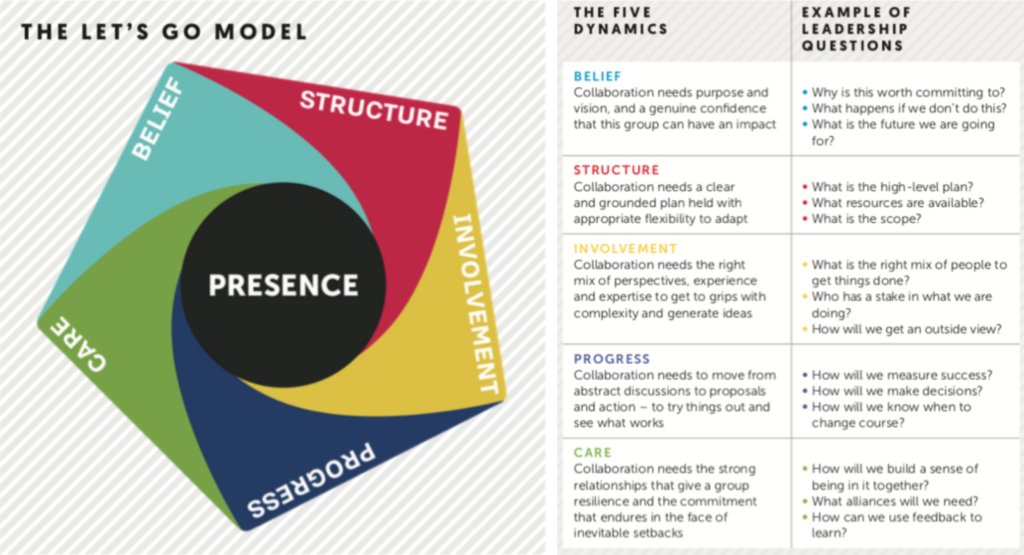Collaboration isn’t rocket science, it’s horticulture, writes Richard Watkins
Productive collaboration is more like tending a garden than building a spaceship. There is always something that needs your attention, but with the right tools everyone can get good things to grow. The Let’s Go Model – a tool created to help leaders navigate collaboration – outlines the five dynamics you need to tend to.
Is collaboration over-ripe?
Encouragements to collaborate are all around us, with 30% of FTSE 100 companies having collaboration or teamwork as one of their values. It was back in 2012 that the IBM Global CEO Study really announced its significance: “Collaboration is the number one trait CEOs are seeking in their employees, with 75% of CEOs calling it critical.” And if the world has moved on since then, it’s not towards silos – most sectors are waking up to the interdependencies between initiatives as they attempt to navigate complexity.
But everything ripe needs to be picked at the right time. And some are starting to bemoan that collaboration is a rotten fruit. The Economist wrote about the ‘collaboration curse’, decrying what it saw as the distracting enemy of “deep work”. Meanwhile, Rob Cross’s HBR article ‘Collaborative Overload’ outlined how the best collaborators become workflow bottlenecks and burn out. Before we can even get into assessments of whether collaboration has gone too far, we need to clarify what we mean. When everything from open-plan offices to joint ventures gets labelled ‘collaboration’, its definition is muddy. As with other vast concepts like strategy and innovation, if we aren’t careful collaboration ends up meaning everything and nothing – and the whole conversation starts to leave a bad taste.
What is collaboration, anyway?
For the sake of this article – and for the sake of our sanity more broadly – when we speak about collaboration we mean getting things done in groups, where we are working across borders – be they functional, regional, or organizational. Whether a collaboration is something little (like aligning pricing across a portfolio of products) or something big (like creating a cross-division or cross-company strategy), it can always be understood as a specific activity in which people from across boundaries work together to get something done.
So we should stop using collaboration as a synonym for being nice to work with, or saying “could you be more collaborative?” as a way to get what we want. Collaboration is not working in an open-plan office; being flooded with chat notifications; or spending time in all-day workshops. These things may or may not come up as part of a collaboration – and they may help or hinder such efforts – but collaboration is simply working together in a group to get an outcome.
With this clarity, it becomes obvious that there is no need to collaborate on everything or with everyone. Many difficult tasks are more efficiently managed and executed solo, or within hierarchical structures. Other initiatives require keeping people informed with brilliant communication – but with no need to input, so they are not collaborative initiatives either. Other times there are sticky politics where you need to negotiate to get what you want – also not collaboration. The rightful home for collaboration is in challenges that are important, complex and shared.
Collaboration is neither the free-for-all chaos of doomsayers, nor the utopia painted by enthusiasts. Tackling complex challenges in groups and getting to outcomes demands effective sponsorship, clear ownership and being thoughtful about the right structures. And it won’t always be pleasant: collaboration is challenging conversations, hard decisions, and a willingness to compromise. But when we see collaboration as an activity with outcomes – something we can grasp – we can start to see where it is done well or badly; we can understand it, we can get better at it.
Collaboration is not a well-oiled machine
The metaphors we use have a big impact on how we think and act, and much of our organizational language is rooted in the idea that a company is a bit like a machine. We go on an ‘efficiency drive’, we want to put some ‘oil in the cogs’, and hope to ‘isolate problems’ and ‘engineer’ a solution so that things can ‘run smoothly’. For simple problems that can be controlled in a hierarchy, the machine metaphor may be suitable: we must clarify, systemize, optimize. But when we are faced with complex problems and need to collaborate across boundaries it is insufficient:

A machine is about logic and functionality, but collaboration requires harnessing the human energy of a group into a shared direction

A machine follows a program and enforces rules, but collaboration needs a framework that can flex and adapt against principles

A machine needs clear information, but in collaboration we need to embrace complexity which means we need creativity and wisdom

A machine efficiently executes best practice, but collaboration requires experimentation, measurement and decision-making in ambiguity

A machine works by analysing the cold hard facts, but collaboration needs us to connect to emotions, which are signals of what needs attention in a group
Think about collaboration like a garden
Metaphors are of course always imperfect, but in our work we find it helpful to think of collaboration as like tending a garden. Like a garden, collaboration is a joyful, messy, human endeavour. You don’t ever get a garden right or wrong, instead it always needs work and what it needs changes with the seasons. The head gardener is no distant supervisor, but a wise and experienced practitioner.
You can’t garden at a distance or only in fair weather – you need to get outside in the rain, and learn what works by getting stuck into doing. You can’t perfectly isolate problems using logic because a garden – like a group – is an interdependent system.
The Let’s Go model

Leading collaboration is different from hierarchical leadership, because the leader sits at the centre of the action holding the objective, not at the top managing the objective. Our Let’s Go model outlines five distinct and understandable dynamics that are going on in every collaborative group. They don’t happen in a particular order, but are all happening all the time.
The heart of collaboration is Presence (see graphic). As an individual in a collaborative group you need to show up and fully engage – balancing your own experience and expertise with an openness to the rest of the group. In collaboration, there isn’t any one individual who can always know exactly what is needed.
It is these five dynamics that make collaborative groups work or not. A group without Belief might be lethargic or negative; but a group without Progress is more likely to be frustrated or bored. A group without Care will start to fragment or check-out; but a group without Structure might become anxious or lost.
For collaboration, we don’t need perfection on each dynamic, simply enough to do what you are trying to do. For example, a collaboration to optimize a business process will need some Care – a sense of being ‘in it together’ – but you might not need the level of deep camaraderie, learning and resilience required to embark on a high-risk, high-stakes venture.
A good collaborator pays attention to all these dynamics and looks to keep a balance that works. Groups can get trapped on one dynamic as a way to avoid difficult questions about another. We’ve probably all seen collaborations endlessly focus on getting more people Involved and having more ideas, hoping this will bypass a conflict that needs to happen to make meaningful Progress. Sometimes leaders become preoccupied with detailed plans (Structure), when what is needed is to address the glaring lack of Belief in the endeavour.
In practice – from concepts to tools
The Let’s Go Model gives you a precise way to think and talk about collaboration, allowing you to reflect on what is working well and what might need more attention. By using straightforward language, it is applicable in any setting where groups are trying to get something done in collaboration.
This model and approach have already proved helpful in large organizations (most notably: a major telco, a global broadcasting company, and an international insurance company), but also in agencies, start-ups and non-profits. An important part of its appeal has been that the model comes to life for day-to-day application in a range of practical tools for leaders and groups. Two examples:
1 The Collaboration Cards turn the dynamics into 30 conversation cards which are a good way to get important – but sometimes overlooked – discussions “on the table”. These cards have been translated into French and Latin American Spanish – with Mandarin, German and Portuguese translations planned for 2018
2 The Pulse Check turns the dynamics into a psychometric test that lets you gauge the pulse of a team or project group
It was Werner Erhard who said “a problem only exists in the absence of the right conversation”. The Let’s Go model and supporting tools are all ways of getting to the conversation that can move collaboration forwards.
Creating fertile ground
Many organizations are still struggling with how to get their people working together well across boundaries. Much like gardening, there are no magic fixes for collaboration, and improvement takes ongoing work. But thinking of collaboration as groups trying to get things done, and actively engaging with the five dynamics of the Let’s Go model, is good ground for the improved – and targeted – collaboration today’s world so desperately needs.
— Richard Watkins is founder and collaboration expert at UK collaboration consultancy Let’s Go


